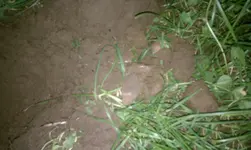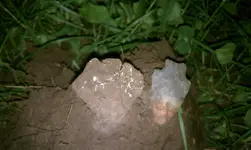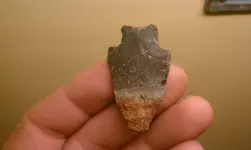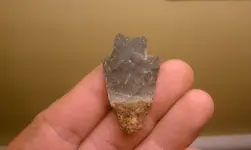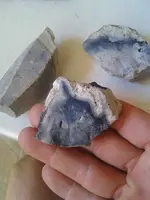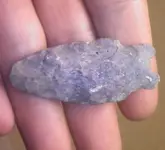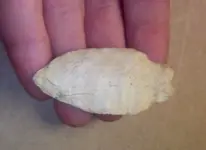You are using an out of date browser. It may not display this or other websites correctly.
You should upgrade or use an alternative browser.
You should upgrade or use an alternative browser.
Three tone Native point located while digging a pulltab signal, ID Please!
- Thread starter FoundInNC
- Start date
NC field hunter
Silver Member
Pretty sure it's rhyolite. The top is the rind or outer layer of the stone. Can't say I've ever seen
A point showing the outer portion of the host stone. I bet that was either the first or the last point produced from its blank.
A point showing the outer portion of the host stone. I bet that was either the first or the last point produced from its blank.
rock
Gold Member
They never finished it by the looks of the tip. Pretty cool how its made. I always figured the tip was chipped first then the rest was done. But I guess not. Nice study piece you have found. Now go back and find some more.
GatorBoy
Gold Member
- Joined
- May 28, 2012
- Messages
- 14,716
- Reaction score
- 6,156
- Golden Thread
- 0
- Primary Interest:
- All Treasure Hunting
Looks complete to me.
Just an interesting piece the maker decided to use.
Looks like a Savannah River point.
Nice find.
Imagine the piece that it was made from coming off the core vertically..... the base being from further to the center of the material and the tip from the outer edge.
Just an interesting piece the maker decided to use.
Looks like a Savannah River point.
Nice find.
Imagine the piece that it was made from coming off the core vertically..... the base being from further to the center of the material and the tip from the outer edge.
Last edited:
unclemac
Gold Member
- Joined
- Oct 12, 2011
- Messages
- 7,442
- Reaction score
- 7,838
- Golden Thread
- 0
- Primary Interest:
- Beach & Shallow Water Hunting
for the life of me I will never understand why you detectorists keep finding point digging random holes. Makes me want to take a shovel out the the woods and dig random holes like a gopher.
GatorBoy
Gold Member
- Joined
- May 28, 2012
- Messages
- 14,716
- Reaction score
- 6,156
- Golden Thread
- 0
- Primary Interest:
- All Treasure Hunting
for the life of me I will never understand why you detectorists keep finding point digging random holes. Makes me want to take a shovel out the the woods and dig random holes like a gopher.
Haha.. so true!
I'm willing to bet there is a source of fresh water nearby.
FoundInNC
Sr. Member
- Joined
- Mar 20, 2012
- Messages
- 458
- Reaction score
- 637
- Golden Thread
- 2
- Location
- Mebane, North Carolina
- 🥇 Banner finds
- 2
- 🏆 Honorable Mentions:
- 4
- Detector(s) used
- Garrett AT Gold and AT Pro
- Primary Interest:
- Metal Detecting
- #9
Thread Owner
Thanks for the ID! What time frame are "Savannah River" points from? Woodland? I believe the stone is rhyolite. For everyone wondering why we detectorists keep finding points in random holes(at colonial sites) the reasoning is simple. Most colonial homes were placed on hilltops, high ground, and near a fresh water source. Natives occupied this same land until the early1700s in some places, so it is just a matter of time before you dig a Native relic.
Brandiwine
Full Member
- Joined
- Mar 3, 2013
- Messages
- 121
- Reaction score
- 94
- Golden Thread
- 0
- Primary Interest:
- All Treasure Hunting
for the life of me I will never understand why you detectorists keep finding point digging random holes. Makes me want to take a shovel out the the woods and dig random holes like a gopher.
I know right? I'm in fields full of plowed debitage, broken pieces and maybe a nice scraper....still no nice points much less a museum grade piece and watching metal detector enthusiasts pull them out randomly makes me wonder...
bci101tractors
Hero Member
Ya, Brandi & Unclemac, they used to make me wonder as well...
I know right? I'm in fields full of plowed debitage, broken pieces and maybe a nice scraper....still no nice points much less a museum grade piece and watching metal detector enthusiasts pull them out randomly makes me wonder...
FoundInNC
Sr. Member
- Joined
- Mar 20, 2012
- Messages
- 458
- Reaction score
- 637
- Golden Thread
- 2
- Location
- Mebane, North Carolina
- 🥇 Banner finds
- 2
- 🏆 Honorable Mentions:
- 4
- Detector(s) used
- Garrett AT Gold and AT Pro
- Primary Interest:
- Metal Detecting
- #13
Thread Owner
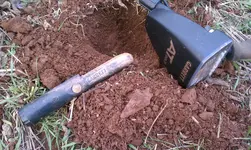
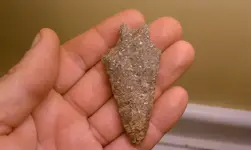

This is the other nice point I dug while detecting, two miles away from the "Savannah River" point. I have found plenty on the surface, in poor condition most of the time, but the two dug ones ae' complete. I had this one Id'ed already, but I forgot what the fellow called it. I am thinking it also started with an "S."
Last edited:
bmartin0693
Sr. Member
- Joined
- Feb 22, 2012
- Messages
- 273
- Reaction score
- 52
- Golden Thread
- 0
- Location
- East Bend, North Carolina
- Primary Interest:
- All Treasure Hunting
Nice Savannah River point! I haven't really seen rhyolite like that here so that material itself looks cool. Here's two that I found in Surry County near Pilot Mtn; one is speckled rhyolite and the other is aphyric rhyolite. That's not too far from Mebane down I-40.
Attachments
bmartin0693
Sr. Member
- Joined
- Feb 22, 2012
- Messages
- 273
- Reaction score
- 52
- Golden Thread
- 0
- Location
- East Bend, North Carolina
- Primary Interest:
- All Treasure Hunting
That last one pictured looks like a Stanley. Or a Stanley converted in a Savannah River. Stanley's have bifurcated bases as well but are a few thousand years older. That material itself, I have never seen before, not sure what that is? Brown rhyolite? That is a neat point too!
Similar threads
- Suggestion
- Replies
- 5
- Views
- 752
- Suggestion
- Replies
- 0
- Views
- 904
- Replies
- 15
- Views
- 604
Users who are viewing this thread
Total: 1 (members: 0, guests: 1)

